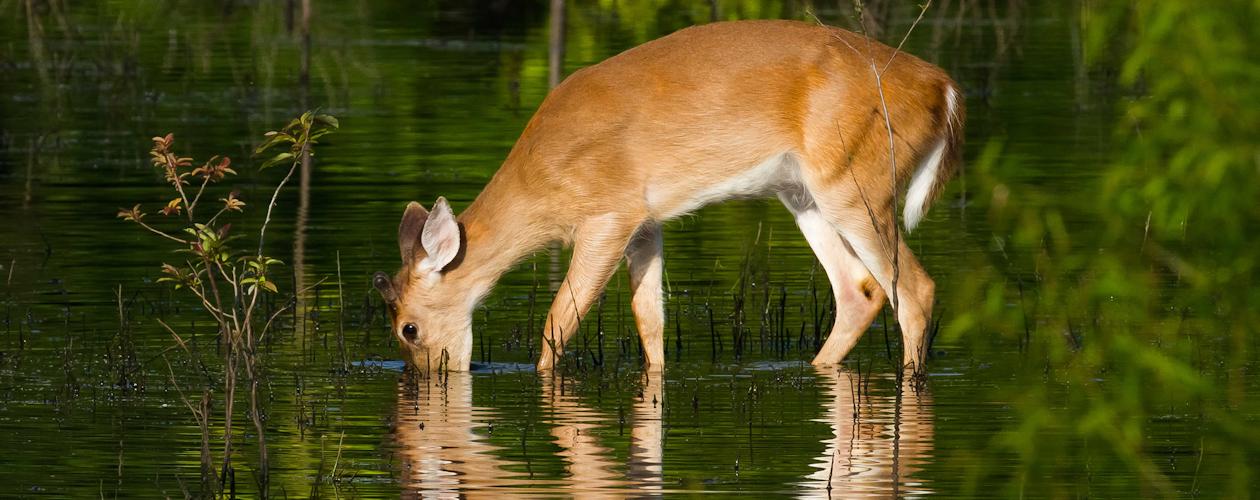Viewing Wildlife in the Kentucky Lake Area
Whether taking a Sunday drive, hiking a scenic trail or biking the roadways around Kentucky and Barkley Lakes, visitors are sure to experience nature in a unique and authentic way. Waterfowl, deer, turkeys and a number of native and migratory birds inhabit the region, making it one of the best destinations for wildlife viewing.
Clarks River Refuge
Situated half an hour from Kentucky Lake, Clarks River Wildlife Refuge is the only National Wildlife Refuge located entirely within the state of Kentucky. It is comprised of over 8,000 acres of land, with a goal of reaching 18,000 acres. It is one of the largest remaining bottomland hard wood forests in the region. Established in 1997, the Refuge is home to an abundance of diverse wildlife.
Visitors can walk along the 1.5-mile rail trail near the town of Benton to get a glimpse of some of the animals that inhabit Clarks River Wildlife Refuge. These animals include whitetail deer, bobcats, river otters and spotted salamanders.
Bird enthusiasts will particularly enjoy spotting rare warblers and thrushes, along with other songbirds, raptors and waterfowl. Clarks River Wildlife Refuge Headquarters is open Monday through Friday from 7 a.m. until 4 p.m. It is closed on all Federal holidays. You can visit their website for more information.
Cross Creeks Wildlife Refuge
Cross Creeks Wildlife Refuge, located four miles east of Dover, Tennessee, was established in 1962. One of the Refuge's primary functions is to provide feeding and resting habitat for migrating birds, especially wintering waterfowl. Visitors can expect to see a variety of ducks and geese, along with herring, osprey, turkey and more.
During Spring, nature watchers will be able to spot wild turkeys, blue winged teal and a number of songbirds migrating through the area. Summer brings beavers, owls, and various species of turtles to the forefront, while deer with fawns become less visible. The blue-winged teal migration begins in early Fall. At this time, visitors can also expect to see monarch butterflies, osprey and whitetail deer. Toward November, wildlife enthusiasts will want to keep a watch out for bald eagles.
Cross Creeks is closed from mid-November to mid-March, to provide waterfowl with refuge for the winter. To get more information on Cross Creeks, visit their website.
Tennessee River Wildlife Refuge
The three units of the Tennessee River Wildlife Refuge - Big Sandy, Duck River, and Busseltown - span 65 miles on and around Kentucky Lake in Tennessee. The Refuge houses a diverse range of habitats, from vegetated wetlands and mudflats to scrub areas and agricultural crops. This range allows for a wide array of wildlife. Just over 300 species of birds have been recorded in the refuge, along with 51 mammals and 89 reptiles and amphibians. Whitetail deer are particularly abundant, as are a number of smaller animals, such as raccoons, squirrels and foxes.
With two hiking trails and four wildlife observation decks, visitors will have plenty of opportunity to see a variety of animals during their stay. The Refuge also offers a number of recreational opportunities, including hunting, fishing and photography.
Tennessee River Wildlife Refuge is open during daylight hours. Visit their website for more information.
Land Between The Lakes
For those birdwatchers and wildlife enthusiasts who will be traveling near the Land Between the Lakes National Recreation Area, a number of additional viewing sites and opportunities are available. Find more information about LBL's Kentucky and Tennessee viewing areas here.








